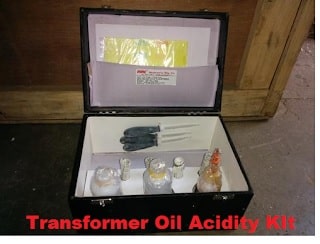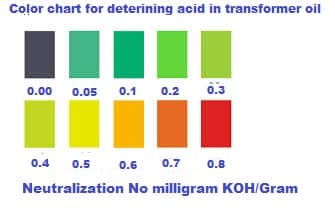The transformer oil is used for insulation and cooling purposes in a transformer. The acidity Test of Transformer oil is a crucial test for analyzing the oxidation of transformer oil. The acidity test measures the acidity content in the transformer oil. The transformer oil Acidity Test is carried out using a transformer oil acidity kit.

Any variation in transformer oil characteristics may lead to transformer failure. The specifications of the transformer oil are given below.
| S.N | Characteristics of Transformer oil | Value |
| 1. | Density Max | 0.89 gm/Cm2 at 29.50 C |
| 2. | Kinematic viscosity Cst at 27°C | 27Cst Maximum |
| 3. | Inter-facial tension at 27°CNewtons/M | 0.04 Minimum |
| 4. | Neutralization value a)Total acidity mg b) Inorganic acidity / Alkalinity | 0.03mg KOH/gm Max Nil. |
| 5. | Oxidation stability a) Neutralization value after oxidation for 16 hrs at 100°C b) Total sludge after oxidation for 164 hrs at 100°C | a) 0.40mg KOH/gm maximum b) 0.10% by weight maximum |
| 6. | Electric strength (Break down voltage) a) New untreated oil b) After treatment | a) 30kv Minimum (RMS) b) 60kv Minimum (RMS) |
| 7. | Flash point Pansky/marten (Closed) | 140°C Min |
| 8. | Pour point | –6°C Maximum |
| 9. | Dielectric Dissipation vector (Ten delta) at 90°C | 0.002 Max |
| 10. | Specific resistance (Resistivity) A) at 90°C B) at 27°C | a) 35 x 1012 Ohm-cm Minimum b)1500 x 1012 Ohm-cm Minimum |
| 11. | Water content (PPM) | 50 PPM Maximum |
| 12. | Aging characteristics after accelerated aging (open breaker method with copper catalyst a) Specific resistance (Resistivity) 1) at 27°C 2) at 90 °C b) Dielectric Dissipation vector (Ten delta at 90°C) 1) Total acidity 2) Total sludge value | 1)2.5 x 1012 Ohm-cm Minimum 2)0.2 x 1012 Ohm-cm Minimum 0.2 Max 1). 0.05mg KOH/gm max 2). 0.05% by weight maximum |
Any deviation in the above-given transformer oil parameter shows that some defect has developed in the transformer insulation system.
Reasons for Acidity in transformer Mineral oil
Sometimes the transformer oil comes into contact with air. This condition happens when there is a leakage of oil from the transformer tank or pipeline. The transformer oil gets oxidized when it comes into contact with air. The oxidation process further accelerates because of high temperature and the catalysts like iron and copper and metallic compounds mixed in the transformer oil.
Effects of Acidity in transformer Mineral oil
The resistivity of the transformer oil is 35 x 1012 Ohm-cm and 1500 x 1012 Ohm-cm at 90°C and 27°C respectively. The resistivity of the transformer oil decreases with increased oxidation—the decreased resistivity of the transformer oil with an increased acidity causes paper destruction. Increased acidity also increases the dissipation factor (tanδ) of the transformer. The rate of sludge formation also increases with increased acidity of the transformer oil.
How to measure the Acidity of transformer oil?
When the acidic material is to be neutralized, the alkali material is added to it. The neutralization of the effect can be examined by the amount of base material added to the acidic material. The same principle is used to calculate the acidity of the transformer oil. The substance required to measure the acidity of transformer oil is potassium hydroxide. It is also commonly referred to as caustic potash.
The potassium hydroxide (KOH) is added to the transformer oil sample in a specific quantity to neutralize the acidity effect of the transformer oil. The acidity of the healthy transformer oil is 0.3 mg KOH/gram. It means 0.3 milligrams of KOH is required to neutralize 1 gram of insulating oil.
Principle of Acidity Test of Transformer Oil
The neutral solution has a PH value of 7. The acidic material has a PH value of less than 7, and the alkali material has a PH value above 7. The acidity of the standard oil is 0.3 mg KOH/gram. When alkali material is added to the transformer oil, it may remain acidic if the alkali is added to neutralize the acidity effect of the transformer oil.
The transformer oil may attain a neutral state with a PH value of 7 if the 0.3-gram alkali is added to the 1-gram transformer oil. If the alkali added to the transformer oil is more than 0.3 mg in 1 gram, the oil may attain a PH value of more than 7, and the oil becomes alkaline.
The transformer oil’s pH value must be below 7. It must also have acidic properties. The acidic nature of the transformer oil can be visualized by observing the color of the strips when they are dipped in it.
Procedure of Acidity Test of Transformer Oil
- One gram of transformer oil is taken to test its acidity. A volumetric syringe takes one milliliter of transformer oil.
- The acid present in the transformer oil is highly dissoluble in the alcohol. So, the dissolved acid in the transformer oil is extracted by adding 1 ml of rectified spirit(ethyl alcohol).
- After shaking the test sample, 1 ml of sodium carbonate is added.
- Then, we add five drops of universal indicator to the sample.
- After adding the universal indicator, the solution changes its color, and the color chart will show how much acid is contained in the insulating oil.

1 thought on “Acidity Test of Transformer Oil”